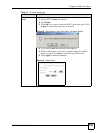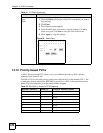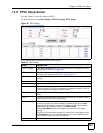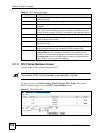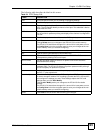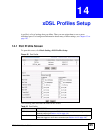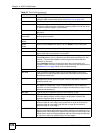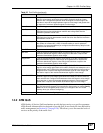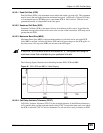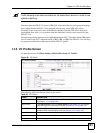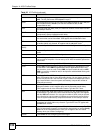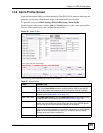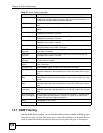
Chapter 14 xDSL Profiles Setup
IES-612-51A User’s Guide
127
14.2 ATM QoS
ATM Quality of Service (QoS) mechanisms provide the best service on a per-flow guarantee.
ATM network infrastructure was designed to provide QoS. It uses fixed cell sizes and built-in
traffic management (see Section 14.3 on page 128). This allows you to fine-tune the levels of
services on the priority of the traffic flow.
Down Shift SNR The upstream down shift signal to noise margin (0-31 dB). When the channel’s
signal to noise margin goes below this number, the device shifts to a lower
transfer rate. Configure the upstream down shift signal to noise margin to be
less than or equal to the target upstream signal to noise margin and greater than
or equal to the minimum upstream signal to noise margin.
Down Stream The following parameters relate to downstream transmissions.
Max Rate Type a maximum downstream transfer rate (64 to 32000 Kbps) bps for this port.
Configure the maximum downstream transfer rate to be greater than the
maximum upstream transfer rate.
Min Rate Type the minimum downstream transfer rate (32 to 32000 Kbps) for this port.
Configure the minimum downstream transfer rate to be less than the maximum
downstream transfer rate.
Interleave Delay Configure this field when you set the Latency Mode field to interleave. Type
the number of milliseconds (1-255) of interleave delay to use for upstream
transfers. It is recommended that you configure the same latency delay for both
upstream and downstream.
Max SNR Type the maximum downstream signal to noise margin (0-31 dB).
Min SNR Type the minimum downstream signal to noise margin (0-31 dB). Configure the
minimum downstream signal to noise margin to be less than or equal to the
maximum downstream signal to noise margin.
Target SNR Type the target downstream signal to noise margin (0-31 dB). Configure the
target downstream signal to noise margin to be greater than or equal to the
minimum downstream signal to noise margin and less than or equal to the
maximum downstream signal to noise margin.
Up Shift SNR The downstream up shift signal to noise margin (0-31 dB). When the channel’s
signal to noise margin goes above this number, the device can attempt to use a
higher transfer rate. Configure the downstream up shift signal to noise margin to
be greater than or equal to the target downstream signal to noise margin and
less than or equal to the maximum downstream signal to noise margin.
Down Shift SNR The downstream down shift signal to noise margin (0-31 dB). When the
channel’s signal to noise margin goes below this number, the device shifts to a
lower transfer rate. Configure the downstream down shift signal to noise margin
to be less than or equal to the target downstream signal to noise margin and
greater than or equal to the minimum downstream signal to noise margin.
Add Click Add to save your changes to the IES-612-51A’s volatile memory. The IES-
612-51A loses these changes if it is turned off or loses power, so use the Config
Save link on the navigation panel to save your changes to the non-volatile
memory when you are done configuring.
Cancel Click Cancel to start configuring the screen again.
Table 25 Port Profile (continued)
LABEL DESCRIPTION



